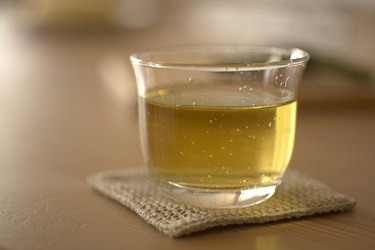
Your pancreas gland is an essential member of the digestive and endocrine systems and is situated just behind the stomach and in front of your spinal column. One of its primary functions is to produce insulin and glucagon, hormones that control blood sugar levels. The pancreas also creates digestive enzymes without which the intestines are unable to process food. Diseases of the pancreas include pancreatic cancer, diabetes and pancreatitis, according to the National Pancreas Foundation.
Green Tea
Video of the Day
Green tea, which is the unfermented foliage of the Camellia sinesis plant, is high in potent antioxidants called polyphenols and may be effective in improving pancreatic health. The University of Maryland Medical Center reports that in one clinical study, those who drank green tea were much less likely to have pancreatic cancer than those who did not imbibe the tea. More animal and human studies are necessary, however, to determine if green tea prevents pancreatic cancer. Green tea is available in standardized extracts or as a tea.
Video of the Day
Garlic Tea
A perennial plant with a pungent odor, garlic is prized for its ability to improve the pancreas's functionality and to treat diabetes. In the book "Garlic: Nature's Perfect Prescription," author C. Gary Hullquist, M.D., relates that studies support garlic's ability to lower blood glucose levels and to increase serum insulin levels. While the physiological action of garlic is not yet fully understood, Hullquist posits that it may boost the pancreas's ability to make insulin, improve workings of insulin receptors and make insulin more readily accessible to the body. Garlic tea is made by boiling 2 cups of water and adding 2 gloves of chopped garlic. Steep, strain and add honey and lemon juice to taste. Check with your physician before using this herb.
Gudmar or Gymnema Sylvestre Tea
Gymnema sylvestre, also known as gudmar, is a plant found in India's tropical forests. Traditional healers have used it for millennia to treat diabetes and regulate blood sugar. In addition, it is thought to reduce sugar cravings and appetite through the action of gymnemic acids, one of its active constituents. A September 2007 article in the "Journal of Clinical Biochemistry and Nutrition" reports that Gymnema sylvestre blocks sugar-binding sites and prevents molecules of sugar from accumulating in the body. This herb is available as a tea in health food stores. As diabetes is a serious condition, consult a doctor before taking this herb for diabetes.
Holy Basil Tea
Holy basil, also known as tulasi, is a fragrant, bushy shrub native to India. Ayurveda, the traditional medical system of India, uses this herb to support the pancreas and treat diabetes. In a May 2007 "Journal of Clinical Biochemistry and Nutrition" article, Dr. Manisha Modal notes that as well as regulating blood sugar, holy basil stimulates the immune system and may contain antibacterial and antiviral properties as well. Holy basil may be taken as a standardized extract or as a tea. Herbs should only be used under a doctor's supervision.